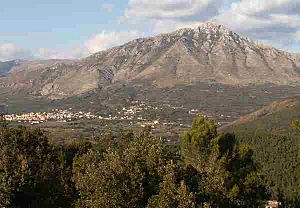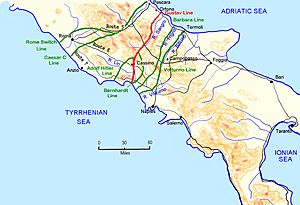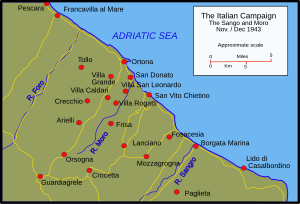Bernhardt Line facts for kids
Quick facts for kids Battle for the Bernhardt Line |
|||||||
|---|---|---|---|---|---|---|---|
| Part of the Italian Campaign of World War II | |||||||
 Mount Sambucaro overlooking the modern town of San Pietro Infine (left) and the ruins of the original town (center). |
|||||||
|
|||||||
| Belligerents | |||||||
|
and others |
|||||||
| Commanders and leaders | |||||||
The Bernhardt Line, also called the Reinhard Line, was a strong German Army defense line in Italy during World War II. It was part of the larger Winter Line defenses. The Allies reached this line in December 1943. It took the US Fifth Army until mid-January 1944 to break through it. The German Tenth Army defended the Bernhardt Line.
Unlike other defense lines, the Bernhardt Line did not stretch across all of Italy. It was a bulge in front of the main Gustav Line. It covered important mountains like Monte Cassino and Monte Sambucaro. Its main goal was to slow down the Allies, not to stop them completely.
Contents
Background: The Fight for Italy
After the Allied invasion of Italy in September 1943, the Italian government gave up. But the German Army kept fighting. The Allied forces, led by General Sir Harold Alexander, moved north. By October, they met the first German defense lines. These lines were meant to delay the Allies and give Germany time to build stronger defenses, known as the Winter Line.
The Allies had a few ways to reach Rome, Italy's capital. One route was along the Adriatic Sea, but it was tough. Another was along the west coast, but the Germans had flooded the area. A third path went inland through the Liri Valley.
Who Was Fighting?
The German forces in Italy were led by Field Marshal Albert Kesselring. The German Tenth Army was in charge of defending the Winter Line. It was split into two main groups.
The Allied forces were called the Allied Armies in Italy (AAI). General Alexander was their commander. He had two main armies:
- The US Fifth Army on the western side, led by Lieutenant General Mark Clark. This army included American, British, and French troops.
- The British Eighth Army on the eastern side, led by General Sir Bernard Montgomery. This army had British, Indian, New Zealand, Canadian, and Polish soldiers.
Eighth Army on the Adriatic Front
The British Eighth Army faced tough battles on the eastern side of Italy. They had to cross several rivers defended by the Germans.
Crossing the Rivers
In early October, the Eighth Army crossed the Biferno River. British Commandos landed from the sea to help. After fierce fighting, the Allies pushed the Germans back to the Trigno River. The Eighth Army then had to pause. Their supply lines were very long, and the roads were bad.
On November 2, the Eighth Army attacked across the Trigno. The Germans pulled back to their forward Winter Line positions behind the Sangro River.
Battle for the Sangro River
The Eighth Army reached the Sangro River on November 9. General Montgomery planned a big attack for November 20. Heavy rains delayed the attack until November 27. This gave the Germans time to bring in more troops.
On November 28, the Eighth Army attacked with strong artillery support. The New Zealand and Indian divisions faced tough German resistance. The fighting was often hand-to-hand. By November 30, the Allies had captured the main Bernhardt defenses on the far side of the Sangro.
The Germans fought hard as they retreated. The New Zealanders tried to capture Orsogna, a key town, but the Germans defended it strongly. Orsogna remained under German control for months.
The Moro River Offensive
After the Sangro battle, the 1st Canadian Infantry Division took over the lead for the next push. They attacked across the Moro River on December 8, heading for Ortona. The Germans fought very stubbornly.
The Battle of Ortona was a week of intense house-to-house fighting. The German paratroopers defended every building. The Canadians finally took Ortona on December 28.
Meanwhile, inland, the fighting around Orsogna continued. But the Allies could not break through. By late December, blizzards and deep snow stopped the Eighth Army's advance. They had moved only 18 miles and suffered 6,500 casualties. General Alexander decided to halt the offensive until spring. The rest of the winter was spent in harsh conditions, with constant small fights.
Fifth Army's Bernhardt Line Offensive
The US Fifth Army, led by Lieutenant General Mark Clark, also faced very difficult conditions. From mid-October to early November, they fought through heavy rains and strong German defenses to reach the Bernhardt Line.
The main path to Rome for the Fifth Army was through the Mignano Gap. This narrow valley was surrounded by tall mountains.
On December 1, the Fifth Army launched a new attack. British and American troops attacked the Camino hill mass. This area had several high peaks, including Monte Camino and Monte la Difensa. It took until December 9 to secure this area from the German 15th Panzergrenadier Division.
On December 8, American forces attacked Monte Sambucaro and the Mignano Gap itself. By December 10, they had taken the mountain peaks. However, the Germans held strong positions in the village of San Pietro Infine. The fighting for San Pietro was very tough. On December 16, the Allies captured Monte Lungo, which overlooked San Pietro. With the high ground on both sides taken, the Germans had to pull back from San Pietro.
The Fifth Army continued to push forward. But the mountainous terrain and bad weather made progress very slow. By the end of December, the Fifth Army had to pause again. They needed to rest, get new supplies, and replace their soldiers. Many soldiers were sick from jaundice, fevers, and trench foot.
The US II Corps attacked again on January 4, 1944. They captured San Vittore and the nearby heights. The British X Corps also attacked, taking Cedro Hill. These victories helped clear the way to the main Gustav Line.
The final push to clear the enemy in front of the Gustav Line began on January 10. Cervaro was taken on January 12. By January 15, the Germans decided their position was too weak and pulled back across the Rapido River. When the US II Corps moved forward, they found no resistance.
Aftermath
It took the Fifth Army six weeks of intense fighting to move just 7 miles through the Bernhardt Line. They suffered 16,000 casualties. By January 15, they had reached the main German defenses of the Gustav Line.
See also
- Allied invasion of Italy
- Battle of San Pietro Infine
- Gustav Line
- U.S. Fifth Army
- Barbara Line
- U.S. 36th Infantry Division
Sources
|




